As a runner, finding the perfect shoe can be a game-changer. The right running shoes can enhance your performance and provide the comfort and cushioning you need to log miles without injury.
At Runner’s World, our team of editorial staff, wear testers, and freelance contributors are always testing the latest models from top brands, so we’ve got hands-on experience with neutral road trainers, trail running shoes, and race-day shoes alike.
With so many options available, it can be overwhelming to choose. That’s why we’re exploring the leading men’s shoe brands that are revolutionizing running in 2025, helping you make an informed decision for your next purchase.
Key Takeaways
- Discover the top brands that are pushing the boundaries of performance and comfort in running shoes.
- Learn how these brands address key factors like cushioning, stability, and durability.
- Understand how to balance performance and price when choosing your next shoe.
- Find out which brands offer the best fit for different running styles.
- Get insights into the innovative technologies that are making a difference in men’s running shoes.
Why Choosing the Right Running Shoe Brand Matters
Selecting the right running shoe brand is a critical decision for runners, influencing performance, comfort, and injury prevention. With numerous brands available, each offering unique technologies and features, understanding the impact of these differences is essential for making an informed choice.
At our dedicated shoe testing lab, we’ve invested significant resources into evaluating various running shoes. We purchase the shoes we test with our own money to avoid brand loyalty and log a minimum of 30-50 miles in each shoe to assess performance and durability. Our rigorous testing includes slicing the shoes to examine their internal composition and using advanced tools like calipers, durometers, and a custom-made smoke machine to gather data on breathability, flexibility, and softness.
The Impact of Proper Footwear on Performance
The right shoe can significantly enhance a runner’s performance by providing the necessary support and comfort. Different brands specialize in various technologies that cater to different aspects of running mechanics, such as energy return, stability features, and cushioning systems. For instance, some brands focus on creating midsoles that offer superior energy return, helping runners maintain their pace with less effort.
| Brand Feature | Description | Benefit to Runner |
|---|---|---|
| Energy Return Technology | Midsoles designed to maximize energy return | Enhanced running efficiency and endurance |
| Stability Features | Supportive elements to stabilize the foot during runs | Reduced risk of injury and improved running posture |
| Cushioning Systems | Advanced cushioning for shock absorption | Improved comfort and reduced impact on joints |
How Brand Technologies Affect Your Running Experience
Brand-specific innovations can dramatically change how a shoe feels underfoot, affecting a runner’s efficiency and endurance. Proprietary technologies from established brands are often backed by extensive research and development, resulting in features that can genuinely enhance the running experience. Understanding how different brands approach shoe design helps runners select footwear that aligns with their specific biomechanical needs and running goals.
By considering the relationship between one’s foot structure and a brand’s typical fit profile, runners can find shoes that work with their anatomy rather than against it. This personalized approach to selecting running shoes can lead to a more comfortable and effective running experience.
Understanding Your Running Style and Needs
Knowing your running style and needs is vital for choosing the most suitable running shoes. To make an informed decision, you need to consider several factors that influence your running experience.
Determining Your Foot Strike Pattern
Understanding your foot strike pattern is crucial as it affects the type of shoe you need. Whether you land on your heel, midfoot, or forefoot determines the required cushioning distribution and support features in a shoe. Many runners are unaware of their foot strike pattern, which can lead to discomfort or injury if the shoes are not appropriately chosen.
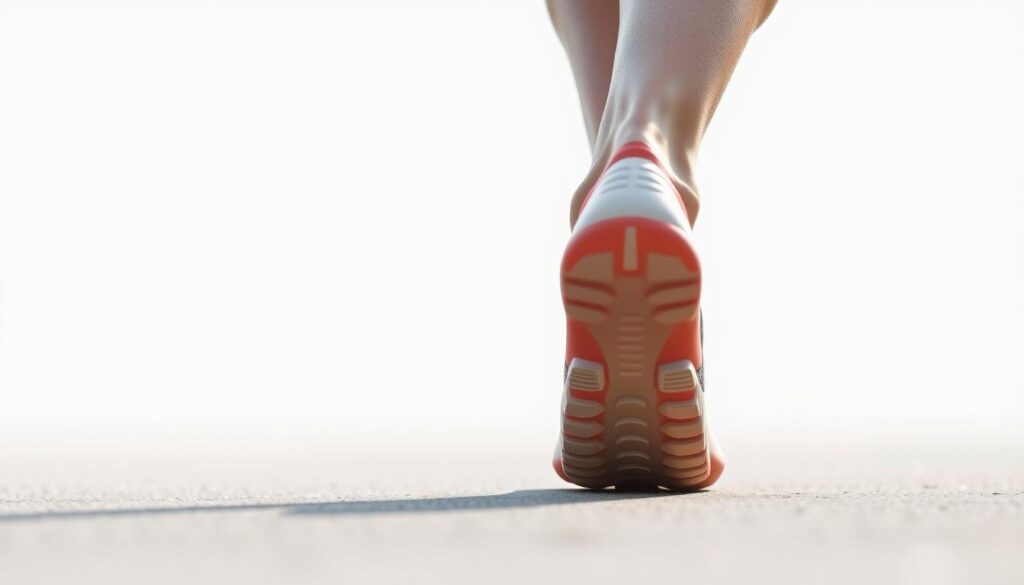
Assessing Your Pronation Type
Your pronation type—whether neutral, overpronation, or underpronation (supination)—significantly influences the right shoe for you. Overpronation occurs when the foot rolls inward excessively, while supination is when it rolls outward. Neutral pronation is the ideal balance. Understanding your pronation type helps in selecting shoes that provide the necessary support and stability for your running mechanics.
Matching Shoes to Your Running Terrain
The terrain you typically run on is another critical factor. If you run mostly on roads, you’ll need road running shoes with smooth outsoles for shock absorption. For trail running, you’ll require trail shoes with aggressive lugs for traction and protective elements. There’s also a hybrid category for those who run on both roads and trails, offering a versatile option.
| Running Terrain | Shoe Type | Key Features |
|---|---|---|
| Road | Road Running Shoes | Smooth outsoles, shock absorption |
| Trail | Trail Running Shoes | Aggressive lugs, protective elements |
| Road & Trail | Hybrid/ Road-to-Trail Shoes | Versatile, suitable for mixed terrain |
By understanding your running style, including your foot strike pattern, pronation type, and typical running terrain, you can make an informed decision when selecting the best running shoes for your needs.
Key Features to Consider When Buying Running Shoes
When it comes to buying running shoes, several key features can make or break your running experience. The right shoe can enhance your performance, provide comfort, and prevent injuries. Understanding these features is crucial for making an informed decision.
Stack Height and Cushioning
Stack height refers to the amount of material between your foot and the ground. More stack height typically means more cushioning and a softer ride, while less stack height offers a more natural feel and greater flexibility. For beginners, a heel stack height of 25-35mm is recommended as it provides a good balance between cushioning and responsiveness.

Heel-to-Toe Drop Explained
The heel-to-toe drop is the difference in height between the heel and the forefoot of the shoe. It’s calculated by subtracting the forefoot stack height from the heel stack height. A drop of 8-12mm is often recommended for beginners as it promotes a relatively natural stride while still offering some cushioning benefits. The industry standard is around 10mm, but different running styles may require different drops.
Weight, Breathability, and Durability Factors
The weight of running shoes affects energy expenditure; lighter shoes can make running feel more efficient but may compromise on protection. Breathability is crucial for comfort during longer runs and warmer conditions, with various upper materials and ventilation systems used by different brands. Durability factors include outsole rubber composition, midsole resilience, and upper construction quality, all varying between brands and price points.
| Feature | Description | Impact on Running |
|---|---|---|
| Stack Height | Amount of material between foot and ground | Affects cushioning and ground feel |
| Heel-to-Toe Drop | Difference in height between heel and forefoot | Influences running posture and muscle engagement |
| Weight | Overall weight of the shoe | Impacts energy expenditure and efficiency |
| Breathability | Ability of the shoe to allow airflow | Affects comfort during longer runs and in warm conditions |
Top 7 Men’s Running Shoe Brands in 2024

The top men’s running shoe brands of 2024 have been selected based on rigorous testing and feedback from the running community. At Runner’s World, we’ve been testing running shoes since 1966, longer than anyone else in the industry. Our comprehensive testing process involves putting thousands of miles on running shoes from every brand available.
Our lab allows us an unprecedented look at the mechanics of your shoes in an objective environment. Every shoe goes through the same tests, regardless of the label on the upper. We work with more than 275 local runners of all abilities, ages, and sizes for real-world wear-testing on various terrains.
How We Selected These Brands
Our selection of the top 7 men’s running shoe brands for 2024 is based on extensive testing across multiple models, evaluating performance, innovation, durability, and value. We’ve analyzed user feedback from thousands of runners across different experience levels to ensure these brands consistently deliver quality.
Each selected brand demonstrates excellence in specific areas like cushioning technology, stability features, lightweight design, or specialized terrain capabilities. Brand consistency, innovation pipeline, and commitment to runner-focused design were key factors in determining which companies made our top 7 list.
Testing Methodology and Criteria
Our testing methodology includes both laboratory analysis of shoe components and real-world performance testing across various distances and conditions. We’ve considered how these brands address the full spectrum of runners’ needs, from casual joggers to competitive athletes.
We’ve evaluated how these brands balance cutting-edge technology with practical benefits that translate to actual performance improvements for everyday runners. The result is a list of brands that truly stand out in the industry.
Nike: Innovation Leader in Running Technology
The world of running shoes has been revolutionized by Nike’s innovative approach to design and technology. With a legacy of pushing the boundaries of what is possible in athletic footwear, Nike continues to be a leader in the industry.
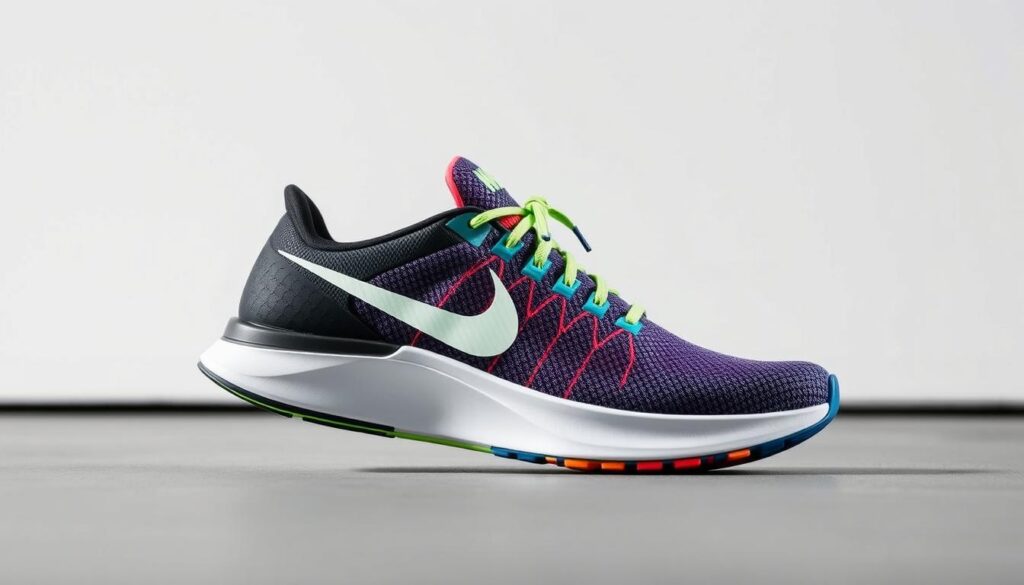
Flagship Models: Alphafly3 and Vaporfly3
Nike’s flagship models, the Alphafly3 and Vaporfly3, represent the pinnacle of running shoe technology. The Alphafly3 features a thick layer of PEBA-based ZoomX cushioning, offering exceptional softness without adding much weight. Dual Zoom Air units and a full-length carbon-fiber plate help maximize energy return, creating an incredibly bouncy and propulsive ride.
The Vaporfly3 offers a more accessible super-shoe option with similar technology to the Alphafly but in a more stable and versatile package, suitable for a wider range of runners. Both models showcase Nike’s commitment to innovation in running shoes.
ZoomX and Air Technology Explained
Nike’s ZoomX foam technology delivers exceptional energy return while maintaining lightweight properties. This technology is central to Nike’s high-performance shoes, providing cushioning and responsiveness. The combination of ZoomX foam and Air technology in Nike’s shoes creates a superior running experience, making them ideal for both professional athletes and casual runners.
The use of Zoom Air units in the heel and forefoot provides additional cushioning and support, enhancing the overall performance of the shoe.
Best Nike Shoes for Different Runner Types
Nike designs shoes for specific runner types, addressing various needs and preferences. For everyday training, the Nike Pegasus line remains a reliable workhorse with Air technology that balances cushioning and responsiveness for high-mileage comfort. Models like the Structure series address stability needs, while the Invincible provides maximum cushioning for recovery runs.
Nike’s commitment to innovation extends to their upper designs, with Flyknit and Atomknit technologies offering targeted support and breathability. Whether you’re a man or woman looking for the perfect running shoe, Nike has a wide range of options to suit your needs.
Asics: Superior Stability and Cushioning
Asics has long been a favorite among runners for its commitment to superior stability and cushioning in their running shoes. With a legacy of innovation, Asics continues to push the boundaries of what running shoes can offer.

Novablast 5 and Metaspeed Sky Paris
The Asics Novablast 5 is our top pick for an all-around running shoe, offering comfort, plushness, and enjoyment for daily mileage. Its resilient FF Blast Max foam provides a bouncy energy return, and the rocker geometry helps maintain a smooth ride. For faster runs, the “trampoline” forefoot of the Novablast 5 delivers great cushioning and a fun, responsive feel.
The Asics Metaspeed Sky Paris stands out as the highest-scoring shoe in our tests, thanks to its incredibly low weight, high energy return FF Turbo Plus foam, and aggressive yet natural geometry. This shoe is our top recommendation for races from a road mile to a full marathon.
FF Blast and FF Turbo Plus Foam Technology
Asics’ FF Blast and FF Turbo Plus foam technologies are designed to deliver different levels of responsiveness and cushioning, catering to the specific needs of various runners. FF Blast provides a balance of cushioning and bounce, making it suitable for daily training. In contrast, FF Turbo Plus foam, found in the Metaspeed Sky Paris, offers a higher energy return, ideal for faster, more competitive runs.
These foam technologies represent Asics’ commitment to innovation and their focus on meeting the diverse needs of runners, from casual joggers to competitive athletes.
Best Asics Shoes for Different Runner Types
Asics designs shoes to accommodate different pronation types, ensuring that runners can find a shoe that matches their specific needs. For overpronators, the Gel-Kayano series offers premium stability, while neutral runners may prefer models like the Cumulus for balanced cushioning.
Whether you’re a runner who needs additional support or one who prefers a more neutral ride, Asics has a shoe designed to enhance your running experience.
Brooks: Comfort-Focused Engineering
Brooks has built a reputation on creating running shoes that are as comfortable as they are functional. With a focus on comfort-focused engineering, Brooks has become a go-to brand for runners seeking high-quality shoes.

Glycerin Max and Adrenaline GTS24
The Glycerin Max showcases Brooks’ approach to maximum cushioning, featuring their innovative DNA Tuned technology. This technology provides adaptive cushioning based on the runner’s weight and stride, making it ideal for runners who prefer a softer ride.
The Adrenaline GTS24 continues Brooks’ tradition of “Go-To Stability” with GuideRails technology, focusing on reducing excess knee motion rather than controlling pronation at the foot. This makes it an excellent choice for runners who need stability without sacrificing comfort.
DNA Tuned Cushioning Technology
Brooks’ DNA Tuned cushioning technology represents a significant innovation in running shoes. By using nitrogen-infused foam with variable cell sizes, Brooks creates targeted cushioning and responsiveness. This technology is particularly beneficial for runners who need a responsive yet cushioned ride.
The DNA Tuned technology is designed to provide the right amount of cushioning and support for different types of runners, making Brooks shoes suitable for a wide range of running styles.
Best Brooks Shoes for Different Runner Types
Brooks designs shoes for different runner types, with models like the Ghost offering neutral cushioning, the Adrenaline providing stability, and the Launch delivering a lighter, faster option. This variety ensures that runners can find a Brooks shoe that fits their specific needs.
Whether you’re a casual runner or a competitive athlete, Brooks has a shoe designed to meet your performance and comfort requirements. Their commitment to sustainable manufacturing is also evident in their use of recycled materials and bio-based components in newer models.
New Balance: Versatility and Width Options
When it comes to running shoes, New Balance stands out for its commitment to catering to various runner needs, including different foot widths. The brand is renowned for offering multiple width options across most of its running shoe models, making it a go-to choice for runners with non-standard foot widths.

Fresh Foam X880v15 and FuelCell Rebel v4
The Fresh Foam X880v15 is praised for its comfortable design, smooth ride, and durable build, making it a great all-around trainer. It features a thick layer of Fresh Foam X EVA cushioning, providing a balanced ride that’s both plush and responsive. On the other hand, the FuelCell Rebel v4 is noted for its light and responsive ride, utilizing FuelCell foam for excellent cushioning and energy return.
FuelCell and Fresh Foam X Technology
New Balance employs two distinct cushioning technologies: Fresh Foam X for a traditional, balanced feel and FuelCell for a bouncier, more responsive ride. Fresh Foam X is designed to provide a soft yet supportive ride, while FuelCell is engineered for responsiveness and energy return, making it ideal for faster-paced runs.
Best New Balance Shoes for Different Runner Types
New Balance designs shoes for various runner types, including models like the 860 for stability, the 1080 for maximum cushioning, and the Rebel for speed-oriented performance. Whether you’re a neutral runner or need additional support, New Balance has a model tailored to your needs.
Saucony: Performance and Responsiveness
For runners seeking both speed and comfort, Saucony stands out as a top brand. Saucony has established itself as a leader in performance-oriented running shoes, with their Endorphin line revolutionizing the balance between speed and comfort.
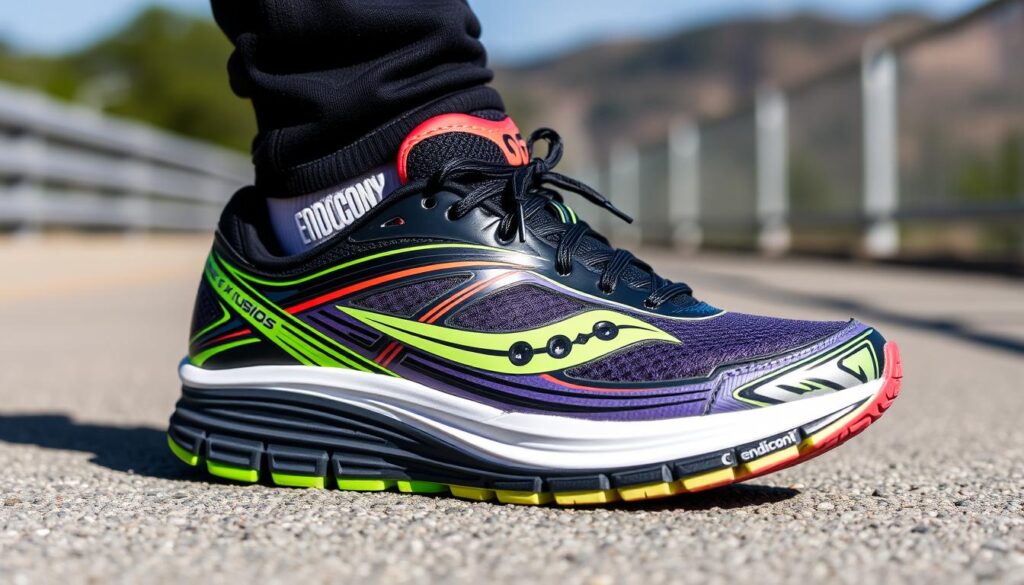
Endorphin Speed4 and Tempus2
The Saucony Endorphin Speed4 is perfect for runners who incorporate faster paces into their routine. It handles any type of run thanks to its responsive PWRRUN PB foam, moderate forefoot rocker, and nylon plate. Our lead tester praised it as a “quiver killer” that easily transitions from speed training to race day and recovery runs.
The Saucony Tempus2 is a brilliant exception in the stability shoe category. It pairs a firmer PWRRUN foam frame with energetic PWRRUN PB foam in the midsole, providing significant support without compromising the ability to change pace.
PWRRUN PB Foam and Speedroll Technology
Saucony’s PWRRUN PB foam technology, made with PEBA-based materials, delivers exceptional energy return while maintaining lightweight properties for efficient running. This technology is a key component in Saucony’s high-performance shoes.
The Speedroll technology creates a forward-rolling geometry that promotes smooth transitions and efficient running mechanics across various paces. This results in a comfortable and responsive shoe that meets the needs of different runners.
Best Saucony Shoes for Different Runner Types
Saucony designs shoes for various runner types, including models like the Guide for moderate stability, the Triumph for maximum cushioning, and the Kinvara for a lightweight, minimal option. Whether you’re looking for heel support or a comfortable fit, Saucony has a shoe that fits your needs and price point.
By offering premium technologies at competitive price points, Saucony balances innovation with value, making their shoes accessible to a wide range of runners.
Adidas: Energy Return and Lightweight Design
Adidas has established itself as a leader in the running shoe market, thanks in part to its emphasis on energy return and lightweight design. The brand’s commitment to innovation is evident in its range of men’s running shoes for 2024, which cater to various running styles and preferences.

Adizero Evo SL and Adios Pro4
The Adizero Evo SL is a race-inspired trainer that offers a balance of cushioning and durability, making it suitable for regular use. It’s the training-oriented version of Adidas’s premier road racing shoe, the Adizero Pro Evo1, and uses the same Lightstrike Pro thermoplastic polyester elastomer (TPE) cushioning.
The Adios Pro4, on the other hand, is notably bouncy with a smooth ride and good traction, making it a favorite among runners. It showcases Adidas’ premium racing technology, using Lightstrike Pro foam and carbon-infused Energy Rods for optimal propulsion.
Lightstrike Pro and Energy Rods Technology
Adidas’ Lightstrike Pro foam technology delivers exceptional energy return while maintaining lightweight properties, making it ideal for both racing and uptempo training. The Energy Rods technology offers a unique alternative to full carbon plates, providing targeted propulsion that works with the foot’s natural movement patterns.
These technologies are key to Adidas’ success in creating responsive running shoes that meet the demands of various runners. The combination of Lightstrike Pro foam and Energy Rods in models like the Adios Pro4 demonstrates Adidas’ commitment to performance innovation.
Best Adidas Shoes for Different Runner Types
Adidas designs shoes for different runner types, with models like the Ultraboost offering plush cushioning, the Solarglide providing stability, and the Adios line delivering speed-oriented performance. Whether you’re a casual runner or a competitive athlete, Adidas has a shoe that can meet your needs.
For runners seeking a balance of performance and style, Adidas’ range of shoes offers something for everyone. From the energy-returning Ultraboost to the speedy Adios, Adidas’ shoes are designed to perform at a high level while maintaining aesthetic appeal for casual wear.
Hoka: Maximum Cushioning and Meta-Rocker
With their signature maximalist design, Hoka running shoes offer unparalleled cushioning. Hoka has revolutionized the shoe market with their approach, proving that highly cushioned shoes can still be lightweight and performance-oriented.

Hoka’s innovative designs cater to various runners‘ needs, providing stability and comfort. Their shoes are designed with a focus on cushioning and a midsole that enhances the running experience.
Mach6 and Skyward X
The Hoka Mach6 is a versatile shoe that offers a responsive and lightweight ride with a firmer feel. It’s suitable for both daily training and faster running. The Skyward X, on the other hand, showcases Hoka’s premium cushioning technology, delivering exceptional impact protection while maintaining an efficient ride through their Meta-Rocker geometry.
Both models highlight Hoka’s commitment to innovation and performance, making them popular among men and women runners alike.
Meta-Rocker and ProFly+ Technology
Hoka’s Meta-Rocker technology creates a unique rolling geometry that promotes efficient forward momentum despite the substantial stack heights of their shoes. This technology, combined with ProFly+, which uses a multi-density midsole approach, provides softer foam at the heel for landing comfort and firmer foam at the forefoot for better toe-off response.
This combination enhances stability and feel, making Hoka shoes a favorite among runners seeking comfort and performance.
Best Hoka Shoes for Different Runner Types
Hoka designs shoes for different runner types, with models like the Arahi providing stability, the Bondi offering maximum cushioning, and the Rincon delivering a lighter, faster option. The price varies across models, catering to a range of budgets.
Whether you’re a casual runner or a competitive athlete, Hoka has a shoe that can meet your needs, providing the right fit and performance.
Daily Trainers vs. Race Day Shoes
Daily trainers and race day shoes serve different functions, and knowing when to use each can enhance a runner’s training and competition outcomes. The primary distinction lies in their design and functionality, tailored to specific running needs.

When to Use Each Type
Daily trainers are designed for the bulk of a runner’s training, offering balanced cushioning, durability, and comfort. They are ideal for easy runs, recovery runs, and long slow distances (LSDs). On the other hand, race day shoes, or competition shoes, are optimized for speed and performance, featuring lightweight construction and responsive materials.
Understanding when to use each type is crucial. Daily trainers should be used for most training runs due to their comfort and durability, while race shoes are best reserved for competitions and specific speed workouts where their unique features can be fully utilized.
- Daily trainers provide the necessary support and comfort for regular training.
- Race day shoes are designed to maximize speed and performance.
Building a Shoe Rotation for Optimal Performance
Building a shoe rotation with complementary models can extend the life of your shoes and provide optimal tools for different training purposes. A basic rotation might include a cushioned daily trainer for easy runs, a lighter tempo shoe for speed work, and a race-specific model for competitions.
| Shoe Type | Primary Use | Key Features |
|---|---|---|
| Daily Trainer | Easy runs, recovery runs, LSDs | Cushioning, durability, comfort |
| Tempo Shoe | Speed work, tempo runs | Lightweight, responsive |
| Race Day Shoe | Competitions, speed workouts | Maximally lightweight, high-performance materials |
Investing in a shoe rotation can be more economical in the long run by reducing wear on any single pair and providing appropriate tools for different training stimuli.
Stability vs. Neutral Running Shoes
Understanding the difference between stability and neutral running shoes is crucial for runners to optimize their performance and comfort. The primary distinction lies in the level of support each type offers to address different pronation patterns.
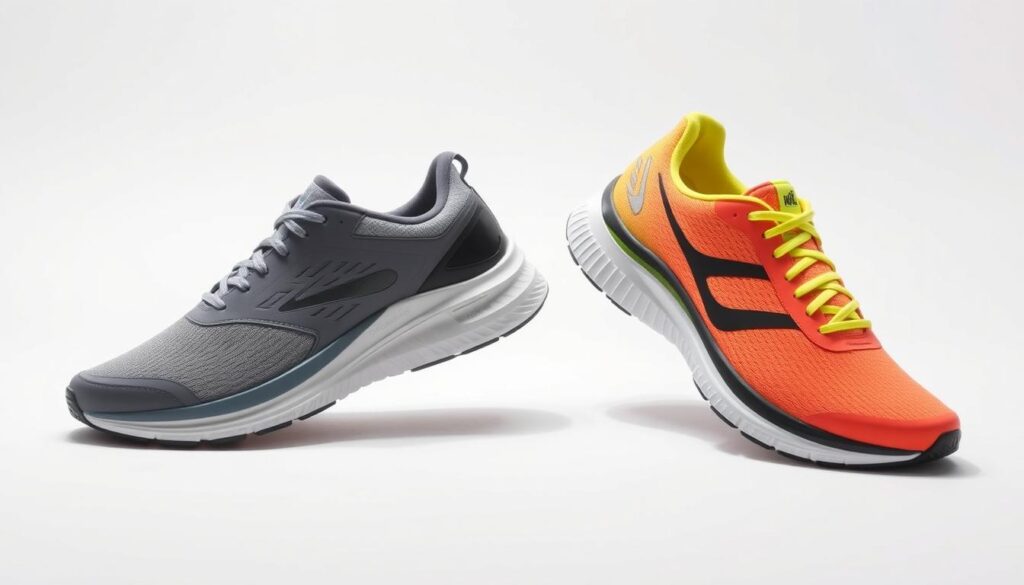
Myths About Pronation and Shoe Selection
Pronation is a natural movement that occurs when the foot strikes the ground. There are three types of pronation: overpronation, neutral pronation, and underpronation (or supination). Overpronation is the most common and occurs when the ankle rolls inward. Neutral pronation is characterized by an even distribution of impact, while underpronation involves the ankle rolling outward.
Recent research has challenged longstanding beliefs about pronation and shoe selection. Many runners successfully use neutral shoes despite having pronation patterns that would traditionally suggest the need for stability shoes. This indicates that comfort may be a more reliable indicator of appropriate shoe choice than pronation type.
- Stability shoes incorporate technologies to control excessive pronation.
- Neutral shoes allow for a more natural foot movement throughout the gait cycle.
- Modern stability shoes provide targeted support rather than rigid control.
Finding the Right Support Level for Your Needs
Understanding the spectrum of stability features helps runners find the right level of support. This ranges from mild guidance elements to more structured motion control designs. The key is to match the shoe type with individual biomechanics and running form.
Finding the right support level often requires experimentation. Many brands now offer stability shoes that don’t sacrifice performance and responsiveness. The best approach to shoe selection combines understanding your biomechanics with attention to how different shoes feel during actual running.
Runners should consider factors such as comfort, performance, and support when choosing between stability and neutral running shoes. By doing so, they can optimize their running experience and potentially reduce the risk of injury.
Carbon Plate Technology: Worth the Hype?
The use of carbon plates in modern running shoes has raised questions about their impact on running efficiency and overall performance. Carbon plate technology has been a game-changer in the running shoe industry, creating a new category of “super shoes” that have helped athletes achieve remarkable results.
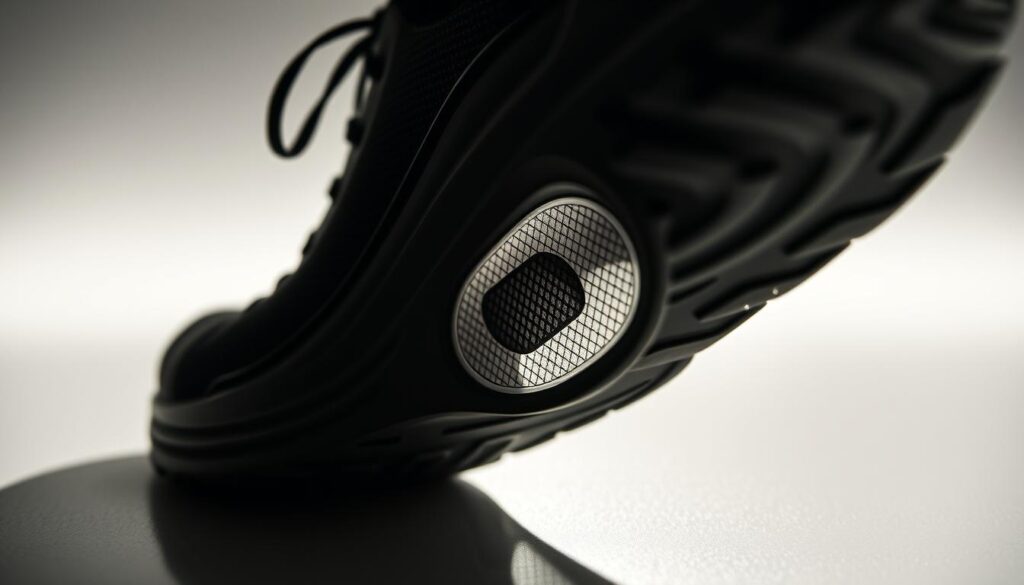
How Carbon Plates Work
Carbon plates don’t work in isolation; they’re part of a system that includes highly responsive foams and rocker geometries. This combination is what gives runners the edge they need. The carbon plate creates a stiffening effect that helps maintain the foot’s structure during toe-off, potentially reducing energy loss and improving running economy. Research has shown that carbon-plated shoes can improve running economy by 4-5% for many runners, though individual results may vary based on running mechanics and pace.
It’s a common misconception that the carbon plate alone makes a shoe fast. In reality, it’s the combination of the plate with highly resilient foam and a rocker geometry that provides the majority of performance enhancements. For instance, Adidas uses carbon-infused rods rather than a full plate in some of their models, achieving great results. This indicates that the plate is just one component of what makes a “super shoe” effective.
When to Invest in Plated Running Shoes
Deciding whether to invest in plated running shoes depends on several factors, including your performance goals, the distances you race, and your budget. These shoes typically come with a premium price tag, so it’s essential to weigh the benefits against the cost. For serious runners looking to gain a competitive edge or achieve a personal best, especially in longer distances like marathons, plated shoes can be a worthwhile investment.
However, for daily training, the benefits of carbon-plated shoes may be less noticeable, and their durability might be lower due to the high-mileage use. They’re most beneficial for race scenarios and specific speed workouts where their performance-enhancing features can be fully utilized.
In conclusion, carbon plate technology is a significant advancement in running shoe design, offering tangible benefits for runners. By understanding how it works and when to use it, runners can make informed decisions about incorporating these shoes into their training and racing arsenal.
Caring for Your Running Shoes to Extend Their Life
Caring for your running shoes is not just about cleanliness; it’s about maintaining their functionality and ensuring they continue to provide the necessary support and performance throughout their lifespan. Proper maintenance can significantly extend the life of your shoes, saving you money and ensuring consistent performance during your runs.
Cleaning and Storage Best Practices
To keep your running shoes in good condition, it’s essential to clean them regularly. Start by removing the insoles and laces to clean them separately. Use a soft brush or cloth to remove dirt and debris from the upper material. For tougher stains, a mild soap solution can be used, but avoid harsh chemicals or machine washing, as these can damage the materials and technologies integrated into the shoes. After cleaning, allow your shoes to air dry away from direct heat.
Proper storage is also crucial. Store your shoes in a dry, temperature-controlled environment away from direct sunlight, which can cause the foam and adhesives to degrade. Rotating between multiple pairs of running shoes can also help extend their lifespan by allowing each pair to fully decompress between uses.
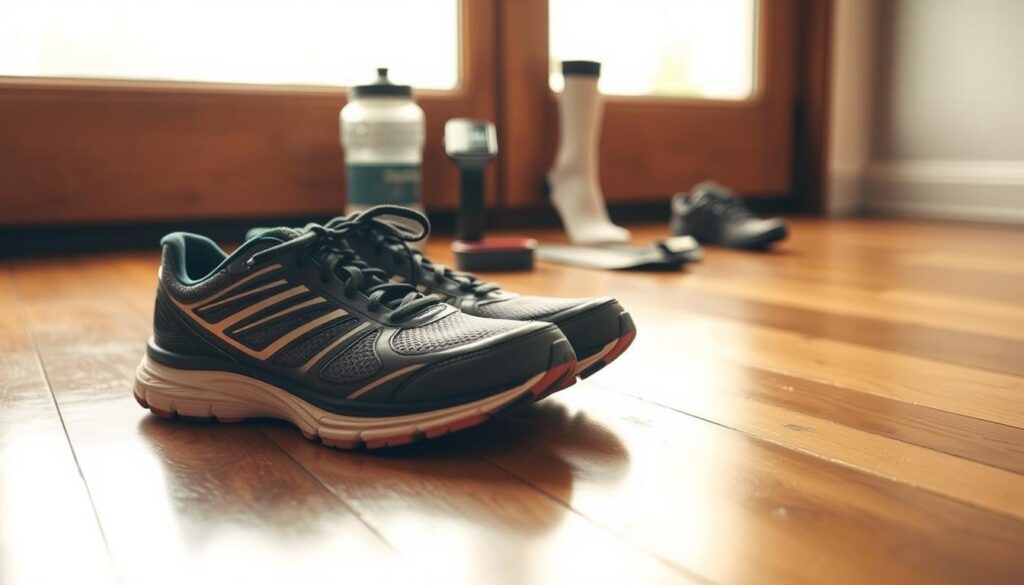
When to Replace Your Running Shoes
Despite proper care, running shoes have a limited lifespan. Most should be replaced after 300-500 miles, depending on factors such as runner weight, running surface, shoe technology, and individual gait patterns. Signs that it’s time to replace your shoes include visible midsole compression, outsole wear, upper deterioration, and changes in how the shoes feel during runs. Different types of shoes have varying lifespans; for example, lightweight racing shoes tend to wear out faster than more substantial daily trainers.
Monitoring the condition of your shoes and being aware of these signs can help you determine when it’s time for a new pair, ensuring you maintain the support and performance you need for your runs.
Conclusion: Finding Your Perfect Running Shoe Match
Finding your perfect running shoe match is a highly personal journey that depends on various factors including biomechanics, running preferences, and performance goals. The best running shoe brands offer diverse options that cater to different needs, from cushioning and stability to lightweight performance and specialized terrain capabilities.
When searching for your ideal shoe, consider trying options from multiple brands on our top7 list, as each company has distinct approaches to fit, cushioning, and performance. Remember that the most expensive shoe isn’t necessarily the best for your specific requirements—focus on finding the right match for your running style rather than the price point.
Your ideal running shoe should feel comfortable immediately, with no break-in period required for basic comfort. As your running evolves, your shoe needs may change, making it worthwhile to reassess your footwear periodically. The perfect running shoe match creates a foundation for enjoyable, injury-resistant running that allows you to focus on your performance and experience rather than foot discomfort.
Ultimately, trust your body’s feedback above marketing claims or trends—the right shoe should disappear on your foot during runs, allowing your natural movement patterns to flow. By understanding your unique needs and preferences, you can find the best running shoes that enhance your running experience.
FAQ
What is the best running shoe brand for long runs?
Brands like Brooks, Asics, and Hoka are known for their comfortable and cushioned shoes, making them suitable for long runs. For instance, Brooks’ Glycerin Max and Hoka’s Mach6 are popular choices among runners.
How do I determine my foot strike pattern?
You can determine your foot strike pattern by analyzing your running form, either by recording yourself running or consulting a running coach. Generally, runners have a heel strike, midfoot strike, or forefoot strike pattern.
What is the difference between stability and neutral running shoes?
Stability shoes are designed for runners with moderate to severe overpronation or supination, providing additional support and stability. Neutral shoes, on the other hand, are suitable for runners with a neutral foot strike pattern, offering a more natural running experience.
Are carbon plate shoes worth the investment?
Carbon plate shoes can be beneficial for runners seeking improved performance, particularly in racing and high-intensity training. They provide a responsive and energy-returning ride, but may not be necessary for casual or long-distance running.
How often should I replace my running shoes?
The lifespan of running shoes depends on various factors, including running frequency, terrain, and shoe quality. Generally, it’s recommended to replace running shoes every 300-500 miles or every 3-6 months.
What is the ideal heel-to-toe drop for running shoes?
The ideal heel-to-toe drop varies depending on individual preferences and running styles. A lower drop (4-6mm) is often preferred by runners with a midfoot or forefoot strike pattern, while a higher drop (8-12mm) may be more suitable for heel strikers.
Can I use daily trainers for racing?
While daily trainers can be used for racing, they may not provide the same level of responsiveness and energy return as dedicated racing shoes. It’s essential to consider your specific needs and goals when choosing a shoe for racing.




